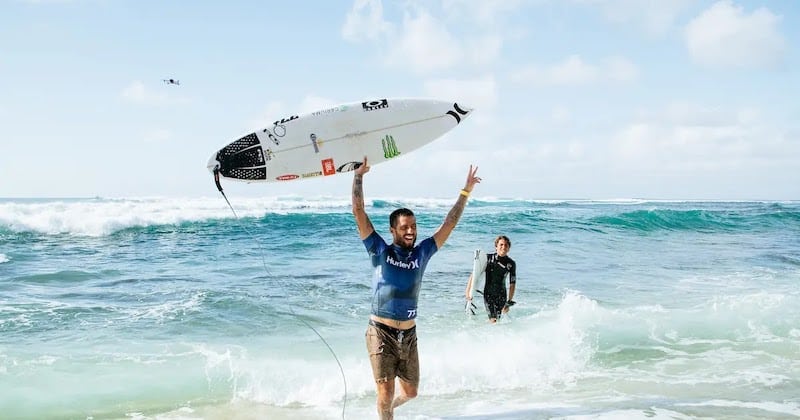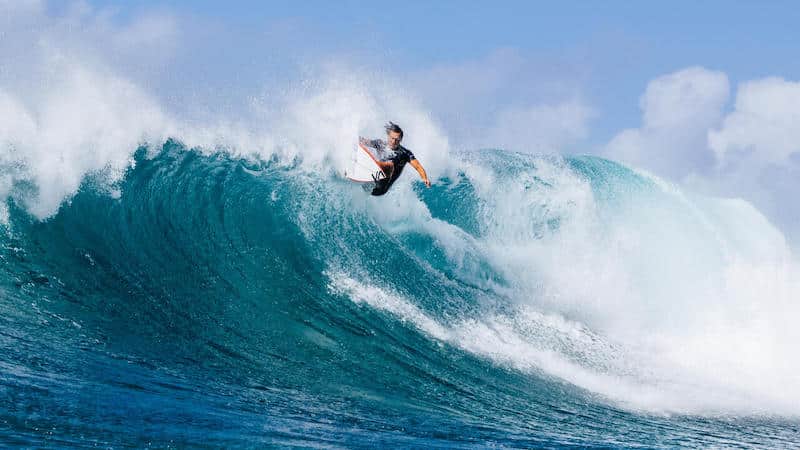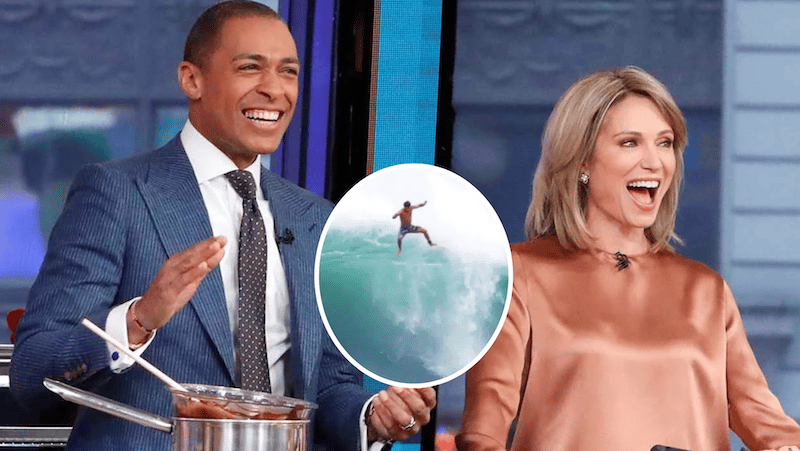Long live Filipe Toledo!
As readers and fans of surfing, I want to thank you.
For the past few weeks I’ve suffered a bit of existential gloom.
Like I’m on a precipice. Pitching over the ledge with the realisation that I’m half a second too late, and what lies beneath is more air and rock than water.
It’s work, it’s addiction, it’s communication, it’s purpose, it’s ChatGPT.
All of which could shove me over at any second.
But Beachgrit, surfing, you…all of this has saved me.
I’ll spare you my extended thoughts about ChatGPT. I plan to write an essay about it elsewhere.
In summary, the arc of my thinking has now arrived at one, simple premise: human readers will always need human writers.
What would ChatGPT make of pro surfing?
It would take a very advanced (or malfunctioning) AI to describe a character like Derek can.
An algorithm would never describe Griffin Colapinto as having a heart-shaped face with dimples in his cheeks where viscous liquids might pool under virginal, thirsty eyes.
Nor could it mimic the style of Chas, wantonly turning noun into verb and back again.
Introspection.
So when I go off on tangents like this, that are little to do with surfing, it’s not contrived, nor self indulgent (it’s a bit self indulgent – all writing is), but rather it’s my attempt to communicate on a simple, human level.
We belong in small groups, reading each other’s body language, looking into eyes, seeing the humanity laid before us. Yet so much of our communication is behind a screen.
So we find little niches where we search for our kin. Places where we can communicate with people we understand, people we could read face-to-face.
That’s what Beachgrit is.
We’re all here. Not because of me or because of you, but because of what we’re doing together. This frivolous, pointless joy of watching men pit themselves against the ocean and wiggle watery, pretty patterns for us to ooh and ahh and spit and howl at.
The words we exchange become bridges to this experience.
And today, at Sunset Beach, was as good a finals’ day experience as we might hope for. A day unimpeded by wave quality, questionable judging, or bland commentary.
Just pure surfing.
Ok, ok. There were some lully heats early on. Dave Prodan appeared via video link at some point and delivered some grey word sludge. Kaipo referred to the shaper rankings as “a really powerful storyline”.
And the “Stay Tuned” screens and ad breaks IN THE MIDDLE OF TIGHT HEATS were infuriating.
But apart from all that.
Jack Robinson trounced Nat Young in the first quarter final of the day, before eventually falling to a sparkling Colapinto.
Ethan Ewing went with a whimper, caught in the eye of a lull. It would have been good to see him in the later heats.
He sat for twenty-two minutes before attempting a wave. For once, his timing was off, and in comparison to Colapinto it looked like he had seaweed on his fins. Griffin surfed like he’d had a whole bag of Skittles.
I noted Colapinto exchanging some dialogue with coach Tom Whittaker as he paddled back to the peak. I’ll need to scan the rulebook, but I didn’t think that was allowed mid-heat.
On the other side of the draw, God downed tools and went out for a fag to leave Caio Ibelli and Filipe Toledo to sort things out themselves.
Toledo was ruthless and incisive.
Laying down a glorious top to bottom arc which was the turn of the day to this stage, he paddled in with over a minute to go. Contrary to how it might appear, there was no arrogance in this, only a justified certainty that Caio didn’t have anything like that in his locker.
This set-up a tantalising match-up with Joao Chianca, who had carried his brutal form of the previous day of competition to dispatch Matt McGillivray.
Both semi-finals were high quality affairs, in terms of the match-ups and the resulting performances.
This might seem like the kind of trite observation you get from the booth, but today each man truly seemed at the peak of his powers.
Griffin Colapinto had risen fierce this morning, writing in his journal, “I am calm. I am confident. I am powerful. I am fearless. I am present.”
Regardless of how you feel about this, or the fact he chooses to share it, you can’t deny he was all of these things.
Rhythm is vital in surfing, and Griffin was feeling it today. Against Robinson, he had one of those performances where his competitor seemed to fade into the background, leaving just him and a perfect canvas for a silky forehand blitz.
Kelly Slater revealed recently that one of his tactics was always to surf against the man, not the waves. I can see how this works, but today Colapinto was in a headspace where the man hardly mattered.
And when the man is Jack Robinson, that’s worth extra kudos.
Robinson, for his part, did very little wrong. There’s no shame in losing with a 16.33 heat total, nor in having a nose for barrels like a pig hunting truffles. I eagerly await the day Robinson, Medina and Florence can go toe-to-toe in a pure tube slug fest.
Given the 6/1 odds the bookies were offering on Griffin prior to this semi, they clearly hadn’t read his journal.
Their favourite was now Filipe Toledo, but a match-up against Joao Chianca, arguably the most on-form surfer of the event by the numbers and the eye-test, was far from given.
Just a note on these numbers: 13.64 for his opening (the second highest score of the entire round); then 16.67, 16.83, 15.23, 15.54.
And you wouldn’t debate any of it.
Strider mentioned the “intensity” of Chianca’s surfing, and for once he was spot on.
It’s not hard to see how it fits the criteria. Every turn he does looks critical, like he’s trying to force the very core of his being through the soles of his feet.
Pre-heat, Toledo prayed on the beach. You’d be forgiven for wondering if he was simply pleading that Chianca didn’t strangle him to death.
After the first exchange, it looked like a real possibility, even if just in the figurative sense.
Both men paddled furiously towards an approaching peak, but it was Chianca that managed to turn and go, a transition that would’ve sent mortal men tumbling over the falls.
He had bullied Toledo to the wave, and his opening score of a 6.50 was followed swiftly by an 8.17 for a ferocity that is becoming his trademark. His turns cause me to utter involuntary ppffoooooooo noises.
But where Chianca was barbaric, Toledo was rapier-like.
The 9.10 awarded to his fourth wave seemed high on first impression, but like the finest rail technicians in the game, it was fully justified in slo-mo.
The aesthetic beauty of these carves was seared into the judges eyes, and there followed an overwhelming sense that Filipe Toledo had a capacity for turns that Joao Chianca does not (yet) possess.
Toledo’s match-up in the final with Griffin Colapinto was mouth watering. From the opening seconds it looked set-up for a banger.
Toledo opened with a 7.83, but right behind him Colapinto dropped a 9.17 after a miraculous end section that he had no right to make.
It was a spectacular finish, but I did question the score, given the only reason he finished in such fashion was because he was late to the section. Surely, when fine waves are on offer, near perfect scores should follow near perfect timing?
The joy in this final were the two wave sets that allowed us direct comparison between rides. The second wave in each set was always a little better, and those went to Filipe.
Griffin was excellent, but Toledo was magnificent. He locked in victory with an 8.27, then added a 9.47 for the highest single wave score of the event. A fitting end to a quality day of professional surf competition.
It was a final between two men unafraid to show some vulnerability, and as fans we should respect that. This sense of shared humanity is really what we’re searching for in live sport.
Toledo was surprisingly emotional in a lengthy post victory interview. Surprising in the sense that he’s already a world champion with many event wins under his belt.
Whatever your qualms about him, on days like today he deserves nothing but respect. Not just for his skill, but for his humanity.
And this is why I thank you.
Because I realise an algorithm could never communicate that.
I realise it could never consider you, a faceless reader, somehow also a friend.
Nor could it understand why this dumb, debatable sport we’re all obsessed with is worth poking, prodding and soliloquising.
And that, to me, makes it more important than ever.
Despite what Apple watch wearing, pool devotees might have you believe, surfing is still a place where both perfection and imperfection can co-exist with glorious unpredictability. A real thing, with real fear and real joy.
I don’t mean to go all Sarah Connor on you, but cling to this, friends. Cling to these dying embers of a life shaped by people.
Algorithms don’t surf.






